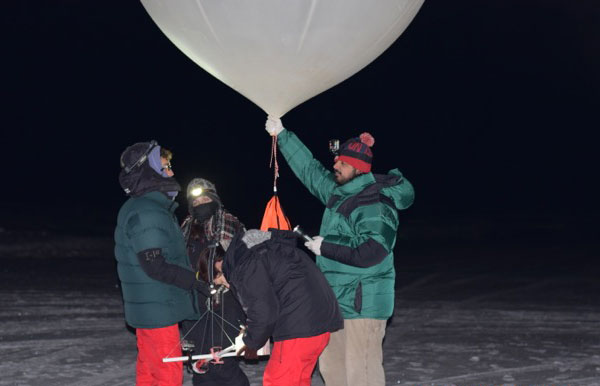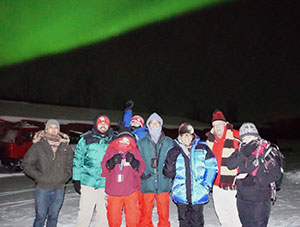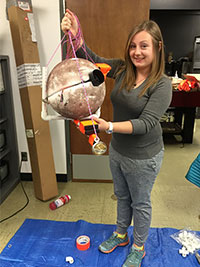
Student Team Monitors Aurora Borealis

Research Funded by NASA’s Science Mission Directorate
Eleven students from the University of Houston traveled to Fairbanks, Alaska, to participate in a NASA-funded research project studying the aurora borealis.
 The Undergraduate Student Instrument Project: UltraLight Mission, a team of 11 College of Natural Sciences and Mathematics (NSM) and Cullen College of Engineering undergraduates, flew student-designed-and-built instrumentation on weather balloons to monitor the aurora borealis (or Northern Lights). Measurements were taken March 15-27.
The Undergraduate Student Instrument Project: UltraLight Mission, a team of 11 College of Natural Sciences and Mathematics (NSM) and Cullen College of Engineering undergraduates, flew student-designed-and-built instrumentation on weather balloons to monitor the aurora borealis (or Northern Lights). Measurements were taken March 15-27.
The activity was part of an undergraduate technology development project, funded through NASA’s Science Mission Directorate, where student teams designed ultra-lightweight (less than 6 lbs.) and ultra-low-cost (less than $3,000 on average) devices to gather scientific data in Alaska.
Six Different Payloads Carrying Experiments
The team, organized by NSM’s Departments of Physics and Earth and Atmospheric Sciences, designed, managed and developed several different devices which were packaged into six different balloon payloads. Each payload carried one or two experiments. The instrumentation and devices gathered electrical, gaseous and other data during the aurora borealis events.
 “My part of the project was to design, build, test and fly a star tracker on a high altitude weather balloon,” said Michelle Nowling, a physics major who plans to graduate in spring 2017. “My star tracker was a camera with a mini on-board computer that could determine its location using the stars. The current design requires post-processing.”
“My part of the project was to design, build, test and fly a star tracker on a high altitude weather balloon,” said Michelle Nowling, a physics major who plans to graduate in spring 2017. “My star tracker was a camera with a mini on-board computer that could determine its location using the stars. The current design requires post-processing.”
Daniel Canales, who received a bachelor’s degree in environmental sciences with a focus in atmospheric science in May, worked on a project designed to sample stratospheric microbes by means of solution-based filtering. The device also had sensors attached to determine environmental conditions of the bacteria and to compare with other sensors collecting meteorological data.
The students worked on all the power/payload integration aspects of balloon science.
Twelve Successful Flights
Out of 15 launch attempts, the team had 12 actual payload flights. An attempt was made to fly each payload three times.
“The project taught me the importance of planning and teamwork,” Canales said. “I also learned about other fields of research and the difficulties of designing and building instruments.”
Nowling learned about project management and picked up a few new skills. “I operated a handheld aircraft radio and soldered for the first time,” she said.
Nowling’s team plans to fly the star tracker again in July. Data analysis will begin after she returns from an internship at the National Radio Astronomy Observatory in Charlottesville, Va.
Faculty advisors participating in the experiments included Edgar Bering, professor of physics; Barry Lefer, associate professor of atmospheric science; and Bonnie Dunbar, director of the UH STEM Center and M.D. Anderson Professor of Mechanical Engineering.
Kathy Major, College of Natural Sciences and Mathematics